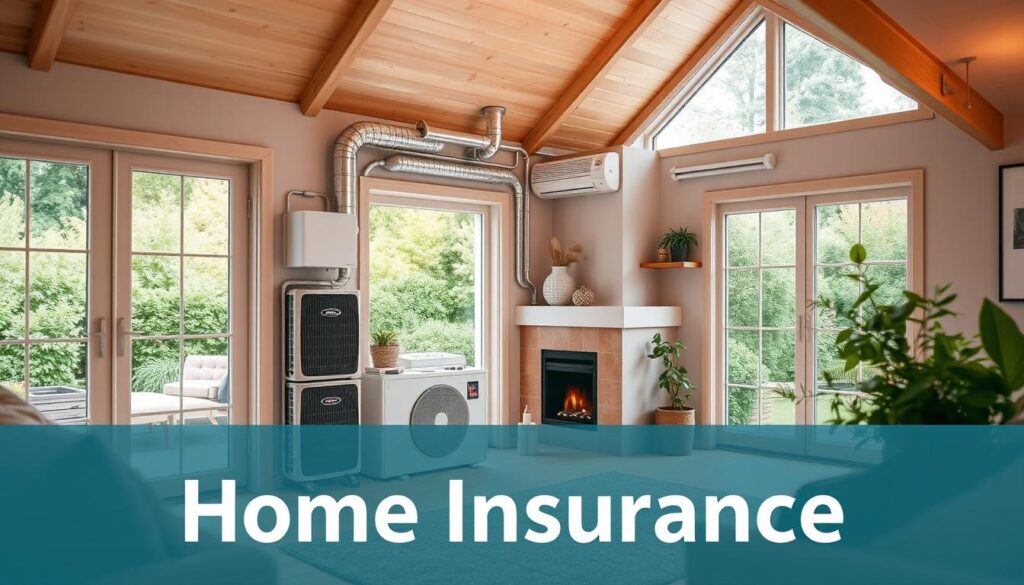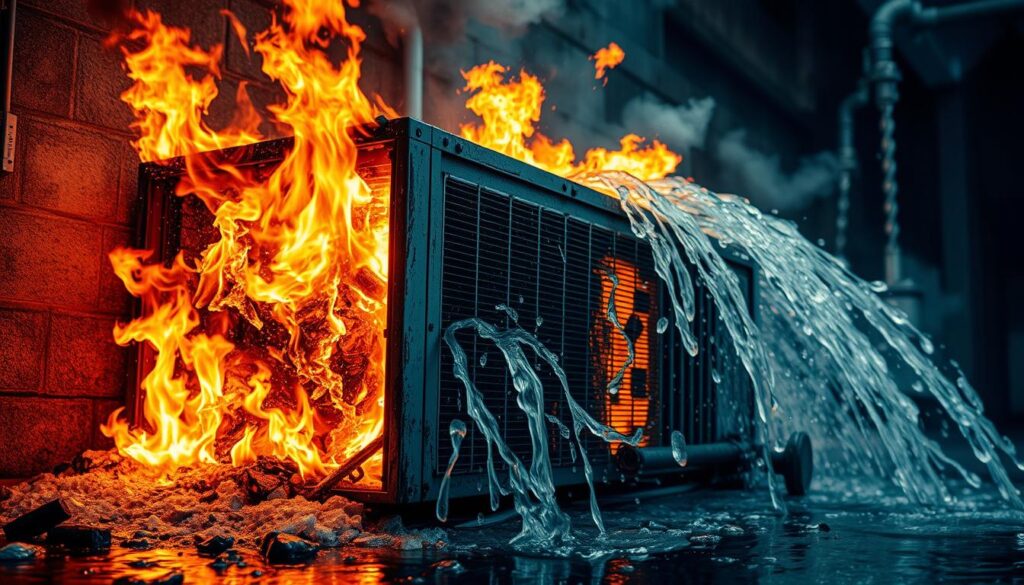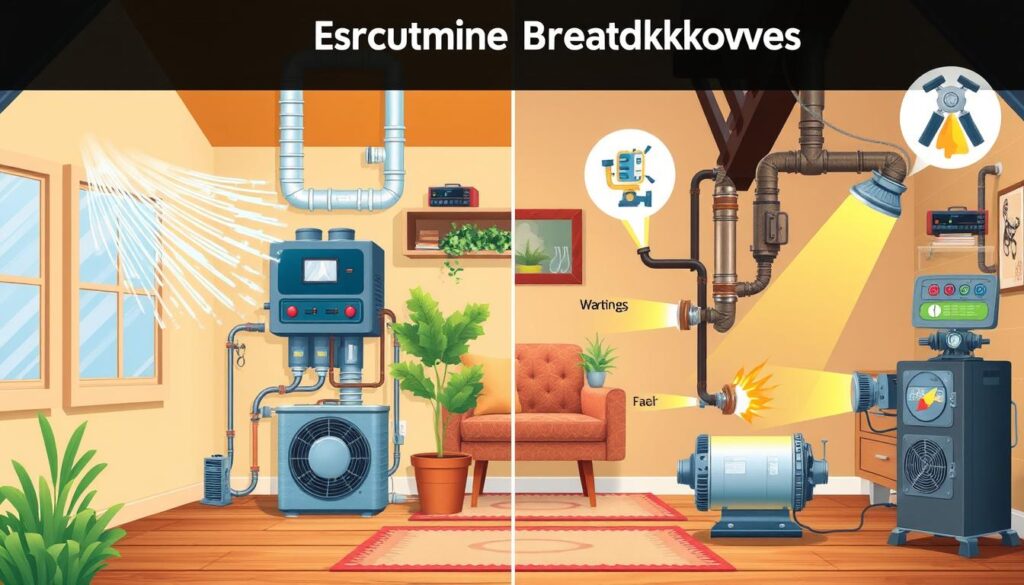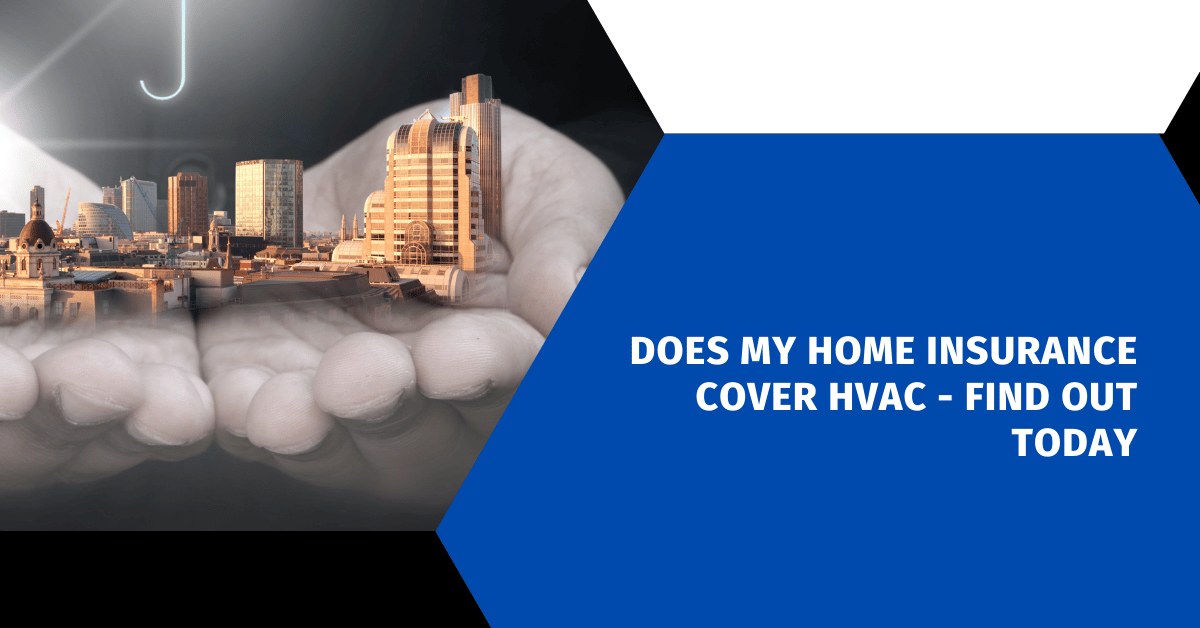Affiliate Disclosure
HVAC Guide Guys is a participant in the Amazon Services LLC Associates Program, an affiliate advertising program designed to provide a means for sites to earn advertising fees by advertising and linking to Amazon.
Your home is your safe haven, and it’s made comfortable by your HVAC system. But, if your air conditioner or furnace breaks down, you might wonder if your insurance covers it. Figuring out your coverage is key to keeping your home comfy and your wallet safe.

Key Takeaways
- Home insurance usually covers HVAC systems damaged by things like fire, theft, or bad weather.
- But, coverage can vary. It might be different for central HVAC units versus window units.
- Damage from normal wear and tear or neglect is not covered by standard policies.
- Options like home warranties and equipment breakdown insurance can offer better HVAC protection.
- It’s crucial to know what your policy covers to avoid unexpected costs.
Table of Contents
Understanding HVAC Coverage in Home Insurance
Home insurance covers your HVAC system, which is key. It protects both central air units and window units. This is crucial for your home’s comfort.
Types of HVAC Systems Covered
Central air systems are covered under “dwelling” in your policy. They’re seen as part of your home’s structure. This means they’re protected against many damages.
Window units, however, are seen as personal property. They’re covered only for specific dangers listed in your policy.
Basic Coverage Components
- Repairs or replacement of HVAC systems damaged by covered perils, such as high winds, fallen trees, hail, lightning strikes, fire, and water damage.
- Compensation for the loss or theft of HVAC equipment, including window units.
- Liability coverage if your HVAC system causes damage to your neighbor’s property.
Policy Distinctions for Different Units
| Central AC Systems | Window Units |
|---|---|
| Covered under “dwelling” coverage | Covered under “personal property” coverage |
| Protected on an “open-peril” basis | Protected on a “named-peril” basis |
| Considered part of the home’s structure | Considered personal belongings |
It’s important to understand your HVAC coverage in home insurance. Knowing your policy helps protect your home and systems. This knowledge helps you make smart choices for your HVAC’s safety.
Does My Home Insurance Cover HVAC: Essential Coverage Details
Understanding your HVAC insurance coverage is key. Knowing what’s covered and what’s not is crucial. This ensures your heating, ventilation, and air conditioning (HVAC) system is well-protected.
Your HVAC insurance coverage depends on the damage cause. Homeowners policies usually cover sudden events like lightning strikes, fires, or storm damage. But, they often don’t cover wear and tear, age-related issues, or damage from neglect. It’s important to review your homeowners policy details to see how much HVAC coverage you have.
Some important covered perils for HVAC systems include:
- Damage from lightning strikes or power surges
- Fires or smoke damage
- Water damage from sudden or accidental events, like HVAC system discharge
- Theft or vandalism
| Covered Event | HVAC Coverage |
|---|---|
| Lightning Strike | Typically covered |
| Fire | Typically covered |
| Hail or Wind Damage | Typically covered |
| Wear and Tear | Not covered |
| Lack of Maintenance | Not covered |
Knowing your HVAC insurance coverage helps protect your system. It also encourages you to keep it well-maintained.
Dwelling Coverage vs. Personal Property Protection for HVAC
Your home insurance policy has different rules for your HVAC system. It depends on if it’s part of your home or personal property. Knowing this helps figure out how insurance handles HVAC problems.
Central AC Systems Under Dwelling Coverage
Central air conditioning systems fall under your home’s coverage. Since they’re part of the home, any issues with your central AC are covered well. This gives you better protection than personal property coverage.
Window Units as Personal Property
Window air conditioning units are seen as personal property. Being easy to move, they’re covered under personal property in your policy. This means their insurance process and limits might be different from your central AC.
It’s key to know the difference between dwelling and personal property coverage for your HVAC. Dwelling coverage usually offers stronger protection. Personal property coverage might have lower limits or extra rules. Talk to your insurance company to find the best coverage for your HVAC.
Knowing your home insurance policy’s HVAC coverage is important. It helps protect your heating and cooling systems from damage or breakdowns. This gives you peace of mind and financial security for your home’s comfort and efficiency.
Common Perils Covered by Home Insurance for HVAC Systems
Your homeowner’s insurance policy likely covers your HVAC system against many common dangers. These dangers include damage from fire, lightning, windstorms, hail, and theft. It also covers damage from falling objects, like tree branches.
But, some types of HVAC damage are not covered by standard home insurance. Flood and earthquake damage need their own special coverage. Knowing what your policy covers helps you understand how well your HVAC is protected.
Covered Perils for HVAC Damage
- Fire
- Lightning strikes
- Windstorms and hail
- Theft and vandalism
- Damage from falling objects (e.g., tree branches)
Excluded Perils for HVAC Damage
- Flood and water damage
- Earthquake-related issues
- Normal wear and tear
- Neglect or lack of maintenance
Knowing what your home insurance covers and doesn’t can help you prepare for HVAC problems. This knowledge helps you make smart choices about your coverage. It ensures your heating and cooling systems are safe from common dangers.
Weather-Related Damage and HVAC Protection
Protecting your HVAC system from weather damage is key. Knowing your home insurance is crucial. Most policies cover damage from storms, lightning, hail, and wind.
Storm and Lightning Coverage
Your policy likely covers damage from severe storms. This includes heavy rain, high winds, and lightning. It covers repairs or replacement of outdoor units and indoor parts affected by the storm. But, always check your policy for specific details and what’s not covered.
Hail and Wind Damage Protection
HVAC systems can get damaged by hail and strong winds. Your insurance might cover this. The protection depends on your HVAC’s age, condition, and the damage’s extent.
| Weather-Related Incident | Typical Home Insurance Coverage |
|---|---|
| Storm and Lightning | Covers damage to HVAC system, including outdoor and indoor components |
| Hail and High Winds | Covers damage to outdoor HVAC units and weather-exposed components |
| Flood and Earthquake | Requires separate policies, not typically included in standard home insurance |
Not all weather damage is covered by standard insurance. Floods, earthquakes, and other disasters need special policies. Make sure to check your policy and consider extra insurance for full HVAC protection.
Fire and Water Damage Coverage for HVAC Units
Your HVAC system is usually covered by home insurance for fire and sudden water damage. This is great because fire and water can really harm your heating, ventilation, and air conditioning. But, it’s key to know the details of this coverage to make sure you’re fully protected.
Fire damage coverage includes direct damage from flames and secondary damage from smoke or firefighting. So, if a fire damages your HVAC system, your insurance should help pay for repairs or a new system. Also, sudden water leaks or pipe bursts that damage your HVAC units are usually covered by your home insurance.
But, not all water damage to your HVAC is covered. Flooding or sewer backups, which aren’t included in standard homeowners policies, won’t cover your HVAC system. To protect against these, you might need to get extra flood or sewer backup insurance.
When you file an HVAC insurance claim for fire or water damage, document everything well. This makes the claims process smoother and increases your chances of getting your HVAC fixed or replaced fully.
| Covered Perils | Exclusions |
|---|---|
|
|

“Protecting your HVAC system from fire and water damage is crucial, as these perils can quickly lead to costly repairs or even the need for a full system replacement.”
Theft and Vandalism Protection for HVAC Systems
Home insurance usually covers HVAC systems damaged by theft or vandalism. If your outdoor HVAC unit is stolen or damaged on purpose, you can file a claim. This will help cover the cost of fixing or replacing it. But, you need to follow certain steps to make sure your claim is successful.
Filing Police Reports
Before you can file an insurance claim for theft or vandalism of your HVAC system, you must file a police report. This is a must for most insurers to confirm the incident and approve your claim. Make sure to get a copy of the police report to add to your claim paperwork.
Claim Documentation Requirements
- Photographs of the damaged or missing HVAC unit
- Receipts for any repairs or replacement parts
- Repair estimates from licensed HVAC contractors
- Copy of the police report detailing the theft or vandalism incident
Having the right documents is key for a successful insurance claim. Your insurer might have specific needs, so check your policy and ask your provider about what you need.
| Covered Perils | Exclusions |
|---|---|
|
|
Knowing what your home insurance covers for theft and vandalism protection helps you prepare. If your HVAC system is targeted by criminals, you can file a claim. This will help get your system working again.
Scenarios When HVAC Damage Isn’t Covered
Your home insurance policy covers HVAC damages from certain “covered perils.” But, it’s key to know what’s not covered. HVAC damage exclusions and insurance policy limitations can make you pay for repairs or replacements yourself in some cases.
For example, your policy might not cover HVAC problems from lack of upkeep, normal wear, or accidents in the backyard. Also, central air conditioners are seen as part of the house, while window units are treated as personal property.
- Wear and tear, lack of maintenance, and mechanical breakdowns are typical exclusions for HVAC coverage.
- Homeowners may need to purchase additional coverage or a home warranty to protect against furnace replacement due to normal aging or electrical/mechanical failures.
- Sudden and accidental damage, such as from fire, lightning, or fallen trees, is more likely to be covered under standard home insurance policies.
Before you file an HVAC-related insurance claim, get repair estimates and compare them to your deductible. This helps decide if filing a claim is wise. If you do file a claim, document the damage with photos and give all needed info to the adjuster.
“Understanding the limitations and exclusions in your home insurance policy is crucial when it comes to protecting your HVAC system. Proactive maintenance and being aware of what is and isn’t covered can help you avoid unexpected out-of-pocket expenses down the line.”
Knowing about HVAC damage exclusions and insurance policy limitations helps you make better choices for your home’s safety and finances.
Equipment Breakdown Coverage and Home Warranties
Protecting your HVAC system has two main options: equipment breakdown coverage and home warranties. Knowing the differences helps you choose what’s best for your home and budget.
Comparing Coverage Options
Equipment breakdown coverage is an insurance add-on for your HVAC and home appliances. It costs $25 to $50 a year. If you need to file a claim, the deductible is $250 to $500.
Home warranties, on the other hand, are contracts for repairs and replacements due to wear and tear. They cost $300 to $1,000 annually. Home warranties cover more, but equipment breakdown coverage is cheaper.
Cost Considerations
Choosing between equipment breakdown coverage and home warranties depends on your HVAC’s age and condition. Home warranties might be better for older or troubled systems. But, if your system is new and well-kept, equipment breakdown coverage could save you money. It offers up to $50,000 for one issue.

“Equipment breakdown coverage is more affordable than home warranty plans, making it a practical choice for homeowners looking to protect their HVAC system and other appliances.”
Additional Insurance Options for HVAC Protection
Standard homeowners insurance often covers HVAC systems in some cases. But, there are more insurance options for better protection of your heating, ventilation, and air conditioning equipment.
Flood insurance is key for those in flood-prone areas. It protects your HVAC from water damage, which regular home insurance usually doesn’t cover.
Earthquake coverage is also important. It keeps your HVAC safe from earthquakes. In earthquake-risk areas, this insurance can save your cooling or heating system.
Water backup protection is another option. It guards your HVAC against sewer or drain backups. This coverage ensures your system is safe from water damage, even from unexpected sources.
These extra insurance options give you peace of mind. They ensure your HVAC system is fully protected against various dangers. By adding these coverages, you boost your home’s climate control equipment protection.
Steps to File an HVAC Insurance Claim
When your home’s HVAC system gets damaged, dealing with the insurance claim can feel overwhelming. But, by following a few key steps, you can make the process smoother and get the help you need. Let’s look at the important steps to file an insurance claim for your HVAC damage.
- Document the Damage: Start by documenting the HVAC damage with clear photos and videos. Show the extent of the damage, any visible problems, and the parts of the system affected.
- Contact Your Insurance Provider: Tell your insurance company about the HVAC damage right away. Give them your policy number and all the details about the incident, like when and how it happened.
- Cooperate with the Adjuster: If needed, meet with the insurance adjuster to check the damage and give any extra information they ask for.
- Gather Receipts and Documentation: Keep a detailed record of all costs related to fixing or replacing your HVAC, like receipts, invoices, and repair estimates.
- Follow Up Regularly: Keep in touch with your insurance provider, giving them any extra information they ask for and checking on your insurance claim status.
By following these steps to file an HVAC insurance claim, you can boost your chances of a quick and successful outcome. Remember, clear HVAC damage documentation and quick communication with your insurer are crucial for a smooth claim filing process.
Filing an HVAC insurance claim can seem complicated, but with the right steps, you can get your system fixed or replaced without spending too much. Stay organized, talk clearly with your insurer, and follow the necessary steps. This way, you can confidently go through the insurance claim process and get your HVAC system working again.
Conclusion
Knowing what your HVAC insurance coverage includes is key to protecting your home. Regular policy reviews and looking into extra coverage are important. Homeowners insurance often covers many unexpected events, but keeping your HVAC in good shape is crucial.
It’s vital to talk to insurance experts to protect your home’s value and finances. They can adjust your coverage to fit your needs. This includes special policies for your HVAC system. Being informed and proactive means you can enjoy your home while feeling secure about your investment.
Getting to know your homeowners protection for HVAC systems is a big step. With the right insurance and upkeep, your heating, cooling, and ventilation will keep you comfy. This is true whether it’s hot or cold outside, or if something unexpected happens.

